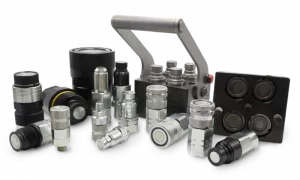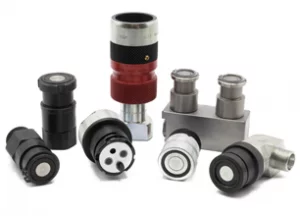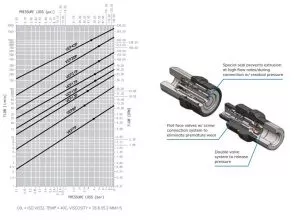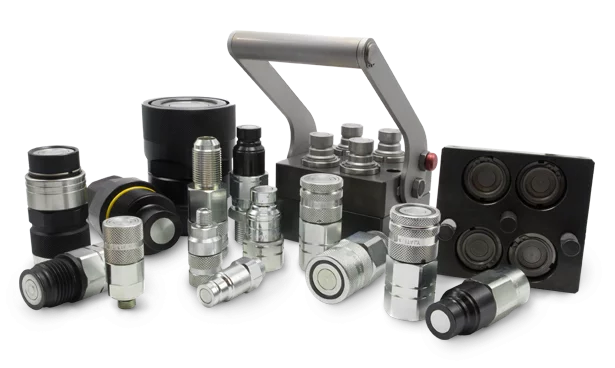Table of Contents
 What is the S.T.A.M.P. Method?
What is the S.T.A.M.P. Method?
Selecting the appropriate quick coupling is crucial for optimal performance and safety of hydraulic systems. Given the variety of options available, making the right choice can be a complex task fraught with technical nuances and practical considerations. The S.T.A.M.P. method is a systematic approach that simplifies this decision-making process by breaking it down into manageable elements encompassing:
- Size
- Temperature
- Application
- Materials/Medium
- Pressure
Stucchi provides the tools and products combined with the expertise of technical representatives ready to assist customers in navigating the quick coupler selection process using the S.T.A.M.P. method. This support ensures that each selection is customized to meet the specific needs of your hydraulic system, enhancing both performance and safety.
S.T.A.M.P. Method Explained
The S.T.A.M.P. method is a structured approach designed to guide the selection of quick couplings for hydraulic systems, ensuring that all critical aspects are considered to optimize performance and reliability. Each letter in the acronym S.T.A.M.P. represents a fundamental factor that must be evaluated when choosing the appropriate quick coupling:
- S = Size: The size of the quick coupling is critical as it must be adequate to handle the flow rate without causing excessive pressure loss or heat generation. This includes considering the nominal inside diameter for optimal fluid flow and the outer dimensions to ensure it fits within the system’s spatial constraints.
- T = Temperature: Temperature plays a dual role, influencing both the medium within the couplings and the environment around them. Selecting the right materials and seals that can withstand these temperatures is crucial to maintaining integrity and functionality under varying operational conditions.
- A = Application: The specific application dictates several design considerations, including the frequency and intensity of pressure impulses, the flow direction, how often connections and disconnections occur, and any external forces that may affect the coupling. Each application may require different features in a quick coupling to address these unique challenges.
- M = Materials / Medium: The materials used for the quick coupling must be compatible with the medium it will encounter, whether it is hydraulic oil, gases, or other substances. Corrosive environments require corrosion-resistant materials like stainless steel or brass to prevent degradation and failure.
- P = Pressure: The pressure rating of the coupling must match or exceed the maximum working pressure and burst pressure demands of the hydraulic system. It is essential to consider the pressures in all states—connected, disconnected, and under residual pressure—to ensure safety and functionality.
By systematically addressing each of these factors using the S.T.A.M.P. method, you can ensure a thorough and effective selection process, leading to the reliable and efficient operation of hydraulic systems. This method helps to organize and simplify the decision-making process, making it more manageable and less prone to errors.
VIDEO – USING THE S.T.A.M.P. METHOD
S for Size
 Selecting the correct size of a quick coupling is crucial for maintaining the efficiency and effectiveness of a hydraulic system. The size directly influences the internal flow diameter, which is essential for optimizing fluid flow. A properly sized coupling ensures that the fluid moves through the system with minimal pressure loss and heat generation, which can otherwise lead to inefficiencies and potential system damage.
Selecting the correct size of a quick coupling is crucial for maintaining the efficiency and effectiveness of a hydraulic system. The size directly influences the internal flow diameter, which is essential for optimizing fluid flow. A properly sized coupling ensures that the fluid moves through the system with minimal pressure loss and heat generation, which can otherwise lead to inefficiencies and potential system damage.
In addition to the internal flow diameter, the overall length and exterior dimensions of the quick coupling must also be considered. These dimensions must be compatible with the available space within the hydraulic system, ensuring that the coupling can be easily accessed and manipulated. Ergonomic considerations are also paramount; the coupling should allow for easy, safe connections and disconnections without putting strain on the operator. This not only enhances safety but also improves the overall usability and maintenance of the system.
T for Temperature
Temperature is a dual-faceted consideration in the selection of quick couplings, affecting both the medium being transported and the external environment.
Medium Temperature Range: The temperature range of the hydraulic medium is critical for selecting the proper sealing materials within the coupling. Seals must be able to withstand the full range of operating temperatures without degrading. For instance, if a system operates at high temperatures, the seals should be made from materials that can maintain their integrity and elasticity under such conditions to prevent leaks and failures.
Environmental Temperature Range: The external or environmental temperature can significantly affect the handling and durability of a coupling. In environments with extreme temperatures, the materials used in the coupling must be able to endure without becoming too brittle (in cold environments) or too soft (in hot environments). This is crucial not only for the longevity of the coupling but also for safety during manual handling and operation. High or low temperatures can also impact the selection of seal materials, as some materials may become less effective or deteriorate faster under certain temperature conditions.
By carefully considering both the medium and environmental temperatures, you can ensure that the selected quick couplings will perform reliably and maintain their integrity over their operational lifespan.
A for Application
The specific application of a quick coupling plays a crucial role in determining its optimal design and features. Various factors need to be considered to ensure that the coupling meets the demands of its intended use:
- Pressure Impulse Frequency and Intensity: The frequency and intensity of pressure impulses that a coupling will endure are critical factors. High-frequency pressure variations demand robust designs that can withstand such dynamic changes with
 out failure.
out failure. - Flow Direction and Changes: The direction of the fluid flow and any changes in direction (such as in systems with multiple branching paths) influence the type of coupling needed. Couplings should facilitate smooth flow transitions to maintain efficiency and minimize wear.
- Connection and Disconnection Frequency: How often a coupling is connected and disconnected influences the choice of coupling type. Frequent coupling and uncoupling require durable mechanisms that can maintain a high level of performance over many cycles without compromising the hydraulic system’s integrity.
- External Loading or Rotating Forces: Any external forces, such as vibration or rotational stresses, that might be applied to the coupling must be considered. These forces can affect the coupling’s longevity and functionality, requiring specialized designs that can tolerate such conditions.
Each application may necessitate different coupling features to address these challenges effectively. For instance, a system that experiences frequent and intense pressure fluctuations might benefit from couplings designed with enhanced flexibility and pressure resistance. Understanding these application-specific requirements is essential for selecting the most suitable quick coupling.
M for Materials / Medium
The selection of materials for quick couplings is critical to ensure compatibility with the medium they will transport and the environment in which they operate. Factors to consider include:
- Compatibility with Medium: The materials used in the construction of quick couplings must be suitable for the type of medium they will carry. For example, hydraulic oil, gases, and other substances may require different materials based on their chemical properties. The material choice affects the coupling’s resistance to wear and corrosion, which in turn impacts its durability and reliability.
- Corrosion Resistance: In environments where corrosive substances or conditions are present, selecting corrosion-resistant materials such as stainless steel, brass, or aluminum is crucial. These materials prevent degradation and extend the life of the coupling, even under harsh conditions.
Seal compatibility is also a significant factor, as the seals within the couplings must effectively contain the medium without leaking. This requires materials that can maintain their sealing properties across the medium’s temperature and chemical range. For instance, seals in couplings used for transporting corrosive fluids may need to be made from specialized polymers that can resist chemical attack.
By carefully choosing the right materials and considering the medium’s properties, quick couplings can be optimized for performance, durability, and safety, ensuring they function effectively within their designated applications.
P for Pressure
Properly matching the pressure ratings of quick couplings with the specific requirements of an application is essential for maintaining system integrity and safety. Understanding and applying the correct pressure parameters can prevent premature failures and ensure optimal performance.
Matching Working and Burst Pressure Ratings
- Working Pressure: The working pressure rating of a quick coupling should at least match, if not exceed, the maximum operating pressure of the hydraulic system under normal conditions. This ensures that the coupling can handle the regular demands of the system without risk of leakage or failure.
- Burst Pressure: The burst pressure rating is equally critical as it indicates the maximum pressure the coupling can withstand before failing. Typically, the burst pressure is several times higher than the working pressure, providing a safety margin to accommodate unexpected pressure spikes. This is vital for preventing catastrophic failures in the event of system malfunctions or sudden pressure surges.
Learn more with our Free Guide: Understanding Working and Burst Pressure Ratings or watch this quick video for detailed information.
Implications of Different States and Residual Pressure
- Pressure in Different States: The pressure ratings might vary when the coupling is connected versus when it is disconnected. It’s important to consider the pressure ratings for both halves of the coupling in their connected and disconnected states. This ensures that both ends can independently withstand the system’s pressure without compromising the overall integrity of the coupling assembly.
- Role of Residual Pressure: In many hydraulic systems, residual pressure can remain within the coupling even when the system is turned off or disconnected. If not properly accounted for, this residual pressure can make reconnecting difficult or lead to sudden discharges when disconnecting, posing safety risks. Selecting a quick disconnect that is capable of handling or relieving residual pressures is crucial for safe operations. Some couplings are specifically designed to connect under residual pressure, facilitating easier and safer connections and disconnections under such conditions.
By carefully considering these aspects of pressure in the selection process, you can ensure that the chosen quick couplings are perfectly suited to the application’s demands, enhancing the hydraulic system’s safety and efficiency.
VIDEO – USING THE S.T.A.M.P. METHOD
Using the S.T.A.M.P. Method Effectively
Applying the S.T.A.M.P. method when selecting quick couplings ensures a thorough and effective approach to match your hydraulic system’s needs. Here’s a step-by-step guide to help you use this method effectively:
- Size:
- Document the flow requirements and spatial constraints of your system.
- Analyze the nominal inside diameter needed for efficient fluid transfer and check the dimensions to ensure the coupling fits within the system without hindering other components.
- Temperature:
- Record the operating temperature range of the medium and the environmental conditions.
- Select materials and seals that can withstand these temperatures without degradation.
- Application:
- Detail the specific operational conditions such as pressure impulses, flow direction, and frequency of connection/disconnection.
- Determine the type of coupling that best suits these operational demands, focusing on durability and ease of use.
- Materials/Medium:
- Identify the chemical properties of the fluids in use.
- Choose coupling materials that are compatible with these properties to prevent corrosion and ensure longevity.
- Pressure:
- Measure the maximum working and burst pressures of your system.
- Match these measurements with the pressure ratings of the couplings, considering both connected and disconnected states.
Tips for Documentation and Analysis:
- Keep a detailed log of all system requirements and potential coupling specifications.
- Use comparison charts to evaluate different couplings against your system’s S.T.A.M.P. criteria.
- Consult with technical experts if the analysis reveals unusual or borderline cases where standard solutions may not suffice.
Resources and Further Reading
 For more detailed information about the sizes, types, and specifications of Stucchi’s hydraulic couplers, the following resources are invaluable:
For more detailed information about the sizes, types, and specifications of Stucchi’s hydraulic couplers, the following resources are invaluable:
- Stucchi Product Charts and Specifications: View products on the website to access detailed product charts and view the Specifications page for port types and coupler sizes. These resources provide comprehensive information on dimensions, materials, pressure ratings, and other critical specifications.
- Stucchi Knowledge Base: For deeper insights into hydraulic coupling specifications visit the Stucchi Knowledge Base. Here, you can find extensive articles and guidance on choosing the right couplings for any application.
- Video: Watch this informative video on Using the S.T.A.M.P. Method to Select Proper Quick Couplings for a visual explanation and further details.
These resources are designed to support you in making informed decisions, ensuring that every coupling you select is perfectly suited to your hydraulic system’s requirements.
The S.T.A.M.P. method offers a systematic and reliable approach to selecting the right quick couplings for your hydraulic systems. By carefully evaluating each aspect—Size, Temperature, Application, Materials/Medium, and Pressure—you ensure that the selected couplings not only fit the operational needs but also enhance system performance and reliability. This methodical approach minimizes the risk of component failure and optimizes functionality, safeguarding your hydraulic systems against potential issues.
Stucchi’s comprehensive range of quick couplings, combined with our detailed product specifications and expert guidance, ensures that you have all the resources needed to make the best selection. For personalized assistance or more information on using the S.T.A.M.P. method for your specific applications, visit our website or contact a Stucchi technical representative. We are dedicated to providing solutions that meet your hydraulic needs with precision and reliability.


